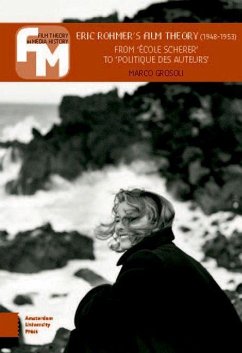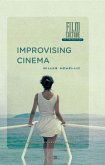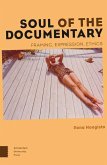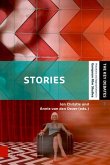Marco Grosoli
Eric Rohmer's Film Theory (1948-1953) (eBook, PDF)
From 'école Scherer' to 'politique des auteurs'
0,00 €
0,00 €
inkl. MwSt.
Sofort per Download lieferbar

0 °P sammeln
0,00 €
Als Download kaufen

0,00 €
inkl. MwSt.
Sofort per Download lieferbar

0 °P sammeln
Jetzt verschenken
Alle Infos zum eBook verschenken
0,00 €
inkl. MwSt.
Sofort per Download lieferbar
Alle Infos zum eBook verschenken

0 °P sammeln
Marco Grosoli
Eric Rohmer's Film Theory (1948-1953) (eBook, PDF)
From 'école Scherer' to 'politique des auteurs'
- Format: PDF
- Merkliste
- Auf die Merkliste
- Bewerten Bewerten
- Teilen
- Produkt teilen
- Produkterinnerung
- Produkterinnerung

Bitte loggen Sie sich zunächst in Ihr Kundenkonto ein oder registrieren Sie sich bei
bücher.de, um das eBook-Abo tolino select nutzen zu können.
Hier können Sie sich einloggen
Hier können Sie sich einloggen
Sie sind bereits eingeloggt. Klicken Sie auf 2. tolino select Abo, um fortzufahren.

Bitte loggen Sie sich zunächst in Ihr Kundenkonto ein oder registrieren Sie sich bei bücher.de, um das eBook-Abo tolino select nutzen zu können.
This book is a first step toward a serious reassessment of the mostly unspoken theoretical and aesthetic premises underlying auteur theory.
- Geräte: PC
- ohne Kopierschutz
- eBook Hilfe
Andere Kunden interessierten sich auch für
![Film Serials and the American Cinema, 1910-1940 (eBook, PDF) Film Serials and the American Cinema, 1910-1940 (eBook, PDF)]() Ilka BraschFilm Serials and the American Cinema, 1910-1940 (eBook, PDF)0,00 €
Ilka BraschFilm Serials and the American Cinema, 1910-1940 (eBook, PDF)0,00 €![Star Wars and the History of Transmedia Storytelling (eBook, PDF) Star Wars and the History of Transmedia Storytelling (eBook, PDF)]() Star Wars and the History of Transmedia Storytelling (eBook, PDF)0,00 €
Star Wars and the History of Transmedia Storytelling (eBook, PDF)0,00 €![Improvising Cinema (eBook, PDF) Improvising Cinema (eBook, PDF)]() Gilles MouëllicImprovising Cinema (eBook, PDF)0,00 €
Gilles MouëllicImprovising Cinema (eBook, PDF)0,00 €![Studying Film with André Bazin (eBook, PDF) Studying Film with André Bazin (eBook, PDF)]() Blandine JoretStudying Film with André Bazin (eBook, PDF)0,00 €
Blandine JoretStudying Film with André Bazin (eBook, PDF)0,00 €![Soul of the Documentary (eBook, PDF) Soul of the Documentary (eBook, PDF)]() Ilona HongistoSoul of the Documentary (eBook, PDF)0,00 €
Ilona HongistoSoul of the Documentary (eBook, PDF)0,00 €![Medium, Messenger, Transmission (eBook, PDF) Medium, Messenger, Transmission (eBook, PDF)]() Sybille KrämerMedium, Messenger, Transmission (eBook, PDF)0,00 €
Sybille KrämerMedium, Messenger, Transmission (eBook, PDF)0,00 €![Stories (eBook, PDF) Stories (eBook, PDF)]() Stories (eBook, PDF)0,00 €
Stories (eBook, PDF)0,00 €-
-
-
This book is a first step toward a serious reassessment of the mostly unspoken theoretical and aesthetic premises underlying auteur theory.
Dieser Download kann aus rechtlichen Gründen nur mit Rechnungsadresse in A, B, BG, CY, CZ, D, DK, EW, E, FIN, F, GR, HR, H, IRL, I, LT, L, LR, M, NL, PL, P, R, S, SLO, SK ausgeliefert werden.
Produktdetails
- Produktdetails
- Verlag: Amsterdam University Press
- Seitenzahl: 328
- Erscheinungstermin: 16. April 2018
- Englisch
- ISBN-13: 9789048537037
- Artikelnr.: 53768217
- Verlag: Amsterdam University Press
- Seitenzahl: 328
- Erscheinungstermin: 16. April 2018
- Englisch
- ISBN-13: 9789048537037
- Artikelnr.: 53768217
- Herstellerkennzeichnung Die Herstellerinformationen sind derzeit nicht verfügbar.
Grosoli Marco :
Marco Grosoli is an Assistant Lecturer in Film Studies at the University of Kent. He authored the first Italian-language monograph on Béla Tarr, co-edited one book on motion capture technologies and one on Guy Debord's cinema.
Marco Grosoli is an Assistant Lecturer in Film Studies at the University of Kent. He authored the first Italian-language monograph on Béla Tarr, co-edited one book on motion capture technologies and one on Guy Debord's cinema.
Introduction 1. A Novelistic Art of Space 1.1. Sartre's ontology 1.2. A
novelistic ontology? 1.3. Cinema: novelistic consciousness qua actual
nothingness 1.4. An art of space 1.5. An art of appearance for appearance's
sake 1.6. Space vs. language 1.7. An art more novelistic than the novel
itself 2. Alexandre Astruc: An Early but Decisive Influence 2.1. Kant's
transcendental aesthetics - and Heidegger's reinterpretation 2.2.
'Dialectique et cinema' 2.3. With and beyond Sartre's Heideggerian
perspective 2.4. The 'Caméra-Stylo' 3. Under and On the Volcano: Rohmer's
Conversion 3.1. The Other 3.2. The triumph of exteriority over interiority
3.3. Pulling phenomenology back to its Kantian roots 3.4. Ethics 3.5. God?
3.6. Echoes of the conversion 4. The Art of Nature 4.1. To show and not to
tell 4.2. Natural beauty 4.3. Immediate mediation 4.4. Movement and
narrative 4.5. Mechanism as the background for freedom 5. Ethics at the
Heart of Aesthetics 5.1. On abjection: The Wages of Fear 5.2. Films with a
soul 5.3. Tragedy 5.4. Solitude morale 5.5. The vertiginous moment: the
reversal between inside and outside 6. After Modernity: Rohmer's Classicism
and Universalism 6.1. Beyond modern art 6.2. Classic = Modern 6.3. An
anti-evolutionist approach 6.4. Universalism 6.5. Authorship and mise en
scene 7. Conclusion.
novelistic ontology? 1.3. Cinema: novelistic consciousness qua actual
nothingness 1.4. An art of space 1.5. An art of appearance for appearance's
sake 1.6. Space vs. language 1.7. An art more novelistic than the novel
itself 2. Alexandre Astruc: An Early but Decisive Influence 2.1. Kant's
transcendental aesthetics - and Heidegger's reinterpretation 2.2.
'Dialectique et cinema' 2.3. With and beyond Sartre's Heideggerian
perspective 2.4. The 'Caméra-Stylo' 3. Under and On the Volcano: Rohmer's
Conversion 3.1. The Other 3.2. The triumph of exteriority over interiority
3.3. Pulling phenomenology back to its Kantian roots 3.4. Ethics 3.5. God?
3.6. Echoes of the conversion 4. The Art of Nature 4.1. To show and not to
tell 4.2. Natural beauty 4.3. Immediate mediation 4.4. Movement and
narrative 4.5. Mechanism as the background for freedom 5. Ethics at the
Heart of Aesthetics 5.1. On abjection: The Wages of Fear 5.2. Films with a
soul 5.3. Tragedy 5.4. Solitude morale 5.5. The vertiginous moment: the
reversal between inside and outside 6. After Modernity: Rohmer's Classicism
and Universalism 6.1. Beyond modern art 6.2. Classic = Modern 6.3. An
anti-evolutionist approach 6.4. Universalism 6.5. Authorship and mise en
scene 7. Conclusion.
Introduction 1. A Novelistic Art of Space 1.1. Sartre's ontology 1.2. A
novelistic ontology? 1.3. Cinema: novelistic consciousness qua actual
nothingness 1.4. An art of space 1.5. An art of appearance for appearance's
sake 1.6. Space vs. language 1.7. An art more novelistic than the novel
itself 2. Alexandre Astruc: An Early but Decisive Influence 2.1. Kant's
transcendental aesthetics - and Heidegger's reinterpretation 2.2.
'Dialectique et cinema' 2.3. With and beyond Sartre's Heideggerian
perspective 2.4. The 'Caméra-Stylo' 3. Under and On the Volcano: Rohmer's
Conversion 3.1. The Other 3.2. The triumph of exteriority over interiority
3.3. Pulling phenomenology back to its Kantian roots 3.4. Ethics 3.5. God?
3.6. Echoes of the conversion 4. The Art of Nature 4.1. To show and not to
tell 4.2. Natural beauty 4.3. Immediate mediation 4.4. Movement and
narrative 4.5. Mechanism as the background for freedom 5. Ethics at the
Heart of Aesthetics 5.1. On abjection: The Wages of Fear 5.2. Films with a
soul 5.3. Tragedy 5.4. Solitude morale 5.5. The vertiginous moment: the
reversal between inside and outside 6. After Modernity: Rohmer's Classicism
and Universalism 6.1. Beyond modern art 6.2. Classic = Modern 6.3. An
anti-evolutionist approach 6.4. Universalism 6.5. Authorship and mise en
scene 7. Conclusion.
novelistic ontology? 1.3. Cinema: novelistic consciousness qua actual
nothingness 1.4. An art of space 1.5. An art of appearance for appearance's
sake 1.6. Space vs. language 1.7. An art more novelistic than the novel
itself 2. Alexandre Astruc: An Early but Decisive Influence 2.1. Kant's
transcendental aesthetics - and Heidegger's reinterpretation 2.2.
'Dialectique et cinema' 2.3. With and beyond Sartre's Heideggerian
perspective 2.4. The 'Caméra-Stylo' 3. Under and On the Volcano: Rohmer's
Conversion 3.1. The Other 3.2. The triumph of exteriority over interiority
3.3. Pulling phenomenology back to its Kantian roots 3.4. Ethics 3.5. God?
3.6. Echoes of the conversion 4. The Art of Nature 4.1. To show and not to
tell 4.2. Natural beauty 4.3. Immediate mediation 4.4. Movement and
narrative 4.5. Mechanism as the background for freedom 5. Ethics at the
Heart of Aesthetics 5.1. On abjection: The Wages of Fear 5.2. Films with a
soul 5.3. Tragedy 5.4. Solitude morale 5.5. The vertiginous moment: the
reversal between inside and outside 6. After Modernity: Rohmer's Classicism
and Universalism 6.1. Beyond modern art 6.2. Classic = Modern 6.3. An
anti-evolutionist approach 6.4. Universalism 6.5. Authorship and mise en
scene 7. Conclusion.







